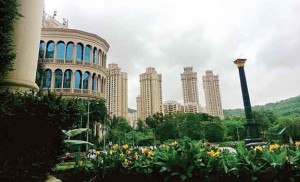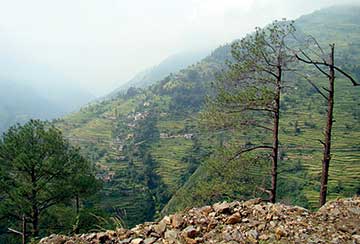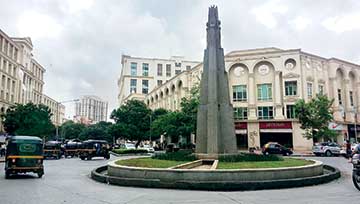Aparajita De
Like all middle class Bengali families, ‘vacation’ was an annual ritual that I looked forward to with great excitement. To my young and impressionable mind, our vacations were no less than the Hollywood Western films that my father was so addicted to. Like the heroes in the movies we would embark on adventures riding into the unknown. Not surprisingly, we spent hours pouring over maps, travelogues, books, stories, films and anything we could lay our hands on to quench our curiosity about the ‘place’ we were going to for our vacation. And thus began my life-long fascination and journey with geography.
 I am sure like me you too enjoy your vacations, but this enjoyment and excitement does not extend to the academic discipline of geography. Unfortunately, the ‘academic’ geography that we encounter in school or later is not even remotely related to our experiences; even our most mundane everyday experiences. Remember the rush of adrenalin that came with the simple discovery of our favourite hideouts or just the new shorter route to school? Geography in school is a rather dull and boring world of ‘facts’; too cut and dried and all too ‘real’ leaving absolutely no room for ‘imagination’. Geography, after all is a ‘science’ based on facts, logic, rationale and analytical thinking and not fiction based on imagination. This emphasis on ‘facts’ was to demystify and sanitize geography of the ‘unrealness’ that imagination creates and put forth a reality that existed independent of one’s experiences, perceptions or imaginations. This attempt to demystify geography has perhaps made it the least understood discipline. The discipline’s obsessions with ‘reality’ or more specifically an objective reality has dehumanized geography and disassociated it from our emotions, feelings, values and experiences. The irony here is that the dehumanizing of geographic reality has displaced and decentered the relationship between man and his environment which is central to any geographical enquiry. No wonder students today doubt and question geography’s relevance as they are unable to relate geographical knowledge to their everyday world, its problems and its needs. Is it then surprising if they ask, ‘Does geography really matter?’
I am sure like me you too enjoy your vacations, but this enjoyment and excitement does not extend to the academic discipline of geography. Unfortunately, the ‘academic’ geography that we encounter in school or later is not even remotely related to our experiences; even our most mundane everyday experiences. Remember the rush of adrenalin that came with the simple discovery of our favourite hideouts or just the new shorter route to school? Geography in school is a rather dull and boring world of ‘facts’; too cut and dried and all too ‘real’ leaving absolutely no room for ‘imagination’. Geography, after all is a ‘science’ based on facts, logic, rationale and analytical thinking and not fiction based on imagination. This emphasis on ‘facts’ was to demystify and sanitize geography of the ‘unrealness’ that imagination creates and put forth a reality that existed independent of one’s experiences, perceptions or imaginations. This attempt to demystify geography has perhaps made it the least understood discipline. The discipline’s obsessions with ‘reality’ or more specifically an objective reality has dehumanized geography and disassociated it from our emotions, feelings, values and experiences. The irony here is that the dehumanizing of geographic reality has displaced and decentered the relationship between man and his environment which is central to any geographical enquiry. No wonder students today doubt and question geography’s relevance as they are unable to relate geographical knowledge to their everyday world, its problems and its needs. Is it then surprising if they ask, ‘Does geography really matter?’
Landscape is…
At this point I would like to introduce to you the field of landscape studies within the broader discipline of geography not as a panacea to the problems of practicing and teaching geography but as a possible alternative for more meaningful engagement with geography. But before we venture further we need to understand what a landscape is and what landscape studies involve. The concept of landscape typically refers to ‘a portion of the Earth’s surface that can be comprehended at a glance’.1 In other words, it denotes not just the physical forms that constitute a landscape but one’s interpretation of the landscape as well. The mere inclusion of the term ‘comprehension’ opens up the field of geography in a completely new direction. It implies that the understanding of geography is not limited to the physical forms of the landscape but takes into account the social processes that shape the understanding of landscape itself; of how people make sense of landscapes that they see and live in. Thus, reality is no longer just a physical reality that is tangible or a fixed given; neither is it an objective reality that is devoid of all humaneness but is enmeshed in our subjectivities – how we feel and attach meaning, the values that it is symbolic of and more importantly our lived experiences of it. Landscape studies hence bring back ‘man’ within the fold of geographical discourse.
Seeing landscapes…
 During one of my visits to Mumbai, I met an auto driver from a village in eastern Uttar Pradesh. He had migrated to the city in the early 80s when he was barely a teenager. Vijay, as he claimed his name to be, was an Amitabh Bachchan fan leaving no doubt in my mind that that was really his name. Bored of his village life, he had fled to Mumbai in search of a new and exciting future. He started his life working in a tea shop and then slowly worked his way up. Today he drives his own auto-rickshaw, his daughter works in an office and his son studies in a college. He informs me that Mumbai is a mayanagri, a place that makes dreams come true; a place that teaches people to dream and achieve them. Vijay asked me, ‘Madam would any other city have given me or my children the opportunity I got here? The city has given us hope and the means to achieve it.’
During one of my visits to Mumbai, I met an auto driver from a village in eastern Uttar Pradesh. He had migrated to the city in the early 80s when he was barely a teenager. Vijay, as he claimed his name to be, was an Amitabh Bachchan fan leaving no doubt in my mind that that was really his name. Bored of his village life, he had fled to Mumbai in search of a new and exciting future. He started his life working in a tea shop and then slowly worked his way up. Today he drives his own auto-rickshaw, his daughter works in an office and his son studies in a college. He informs me that Mumbai is a mayanagri, a place that makes dreams come true; a place that teaches people to dream and achieve them. Vijay asked me, ‘Madam would any other city have given me or my children the opportunity I got here? The city has given us hope and the means to achieve it.’
Clearly, Vijay’s narrative suggests how the landscape of Mumbai is shaped by and integrated with the non-physical social aspects of space that are often intangible and invisible to us. Primarily it is the image and imagination of Mumbai that Vijay holds that integrates with the physical landscape of Mumbai. To him Mumbai is synonymous with and symbolizes opportunity, hopes, and aspirations. Interesting to note is the manner in which the images produced by Bollywood films merge with the landscape of Mumbai evoking certain imaginations and feelings. This brings me to the point that I am trying to make that landscape is ‘defined by our vision and interpreted by our minds’2 and the vision and interpretations are not founded on one’s intimate encounter with and experience of the landscapes alone, but encompasses the remarkable range of our cultural knowledge from literature to painting, films, music, folklore to myths. It is now easy to understand why Cosgrove and Daniels argue that, ‘a landscape is cultural image, a pictorial way of representing, structuring and symbolizing surroundings’.3 Landscape studies incorporate in the understanding of geography WHAT we see with HOW we see it. Clearly, shifting the emphasis on the experience of space and geography and the meanings we draw from it.
Making landscapes…
 One might say that landscapes are restricted to artists and their canvases. But if we look around, ordinary people in everyday life are no less artists. In many ways we are constantly creating and recreating landscapes around us. Take for example our homes; most of us today live in apartments that are highly standardized with a fixed layout but each home is unique and different from the other despite their fixed layouts. This suggests how we transform spaces giving them a unique character that represents the family living in that space, how they use and organize space and in doing so how they give space a different meaning. So it is with spaces on different geographical scales. For instance, city planning and planners, in the same way are artists, only their canvases are our cities. The landscapes they create in the name of utility or functionality are symbolic of our collective dreams, hopes and aspirations as well as our fears and nightmares. Today when we look at the physical landscape of a city, the built environment of the city – its infrastructure and amenities, its institutions and culture we read development, progress, and modernity and we change and transform any elements that are contrary to these imaginations of the cityscape.
One might say that landscapes are restricted to artists and their canvases. But if we look around, ordinary people in everyday life are no less artists. In many ways we are constantly creating and recreating landscapes around us. Take for example our homes; most of us today live in apartments that are highly standardized with a fixed layout but each home is unique and different from the other despite their fixed layouts. This suggests how we transform spaces giving them a unique character that represents the family living in that space, how they use and organize space and in doing so how they give space a different meaning. So it is with spaces on different geographical scales. For instance, city planning and planners, in the same way are artists, only their canvases are our cities. The landscapes they create in the name of utility or functionality are symbolic of our collective dreams, hopes and aspirations as well as our fears and nightmares. Today when we look at the physical landscape of a city, the built environment of the city – its infrastructure and amenities, its institutions and culture we read development, progress, and modernity and we change and transform any elements that are contrary to these imaginations of the cityscape.
Teaching Ideas
Towards a more personalized introduction to geography: Ask students to share photographs and experiences of places they have visited. This will enable the students to understand and rediscover geography through their own experiences.
Knowing the man-environment relationship: Show the students the animated film ‘Over the Hedge’ and discuss how man-environment relations are changing. Also talk about the need for conservation of our forest and wild-life resources.
Understanding climate change: Show the students the animated film series ‘Ice Age’ and have an interactive session on the impact of climate change.
Know your city better: Take the students on a field trip of their own city with a bus-driver/auto-driver/rickshaw-puller and let the students see and experience the city through the eyes of the bus-driver/auto-driver/rickshaw-puller.
Similarly, you could have field trips with people of different professions and occupations to view the city through their eyes and have discussions on the various problems of living in the city.
Mapping places: Use innovative ‘markers’ like landmarks, famous monuments, dance forms, music, festivals and famous personalities, associated with different places to map them.
__________________________________________________________________________________
References
- Jackson J B, (1984), Discovering the Vernacular Landscape, p.8; Yale University Press, New Haven and London.
- ‘Introduction’ pp. 1-3 in Meinig D, ed. (1979) The Interpretation of Ordinary Landscapes. Geographical Essays, Oxford University Press, New York.
- D Cosgrove and S Daniels (1988) The Iconography of Landscape. Cambridge University Press, Cambridge.
The author is an Assistant Professor in urban geography, Department of Geography, Delhi School of Economics, University of Delhi. Her research interest includes urban landscapes and media studies. She is currently the Convener, Media Lab and Digital Library of the Department. She has also extensively participated in the development of NCERT textbooks of geography. She can be reached at ade.dse@gmail.com.
